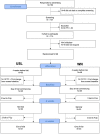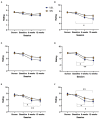A randomized single-blind controlled trial of a prototype digital polytherapeutic for tinnitus
- PMID: 35989940
- PMCID: PMC9389120
- DOI: 10.3389/fneur.2022.958730
A randomized single-blind controlled trial of a prototype digital polytherapeutic for tinnitus
Abstract
Objective: This randomized single-blind controlled trial tested the hypothesis that a prototype digital therapeutic developed to provide goal-based counseling with personalized passive and active game-based sound therapy would provide superior tinnitus outcomes, and similar usability, to a popular passive sound therapy app over a 12 week trial period.
Methods: The digital therapeutic consisted of an app for iPhone or Android smartphone, Bluetooth bone conduction headphones, neck pillow speaker, and a cloud-based clinician dashboard to enable messaging and app personalization. The control app was a popular self-help passive sound therapy app called White Noise Lite (WN). The primary outcome measure was clinically meaningful change in Tinnitus Functional Index (TFI) between baseline and 12 weeks of therapy. Secondary tinnitus measures were the TFI total score and subscales across sessions, rating scales and the Client Oriented Scale of Improvement in Tinnitus (COSIT). Usability of the US and WN interventions were assessed using the System Usability Scale (SUS) and the mHealth App Usability Questionnaire (MAUQ). Ninety-eight participants who were smartphone app users and had chronic moderate-severe tinnitus (>6 months, TFI score > 40) were enrolled and were randomly allocated to one of the intervention groups. Thirty-one participants in the USL group and 30 in the WN group completed 12 weeks of trial.
Results: Mean changes in TFI for the USL group at 6 (16.36, SD 17.96) and 12 weeks (17.83 points, SD 19.87) were clinically meaningful (>13 points reduction), the mean change in WN scores were not clinically meaningful (6 weeks 10.77, SD 18.53; 12 weeks 10.12 points, SD 21.36). A statistically higher proportion of USL participants achieved meaningful TFI change at 6 weeks (55%) and 12 weeks (65%) than the WN group at 6 weeks (33%) and 12 weeks (43%). Mean TFI, rating and COSIT scores favored the US group but were not statistically different from WN. Usability measures were similar for both groups.
Conclusions: The USL group demonstrated a higher proportion of responders than the WN group. The usability of the USL therapeutic was similar to the established WN app. The digital polytherapeutic demonstrated significant benefit for tinnitus reduction supporting further development.
Keywords: clinical trial; digital therapeutic; serious game; sound therapy; tinnitus.
Copyright © 2022 Searchfield and Sanders.
Conflict of interest statement
Author GS is a founder and scientific officer for TrueSilence a Spinout company of the University of Auckland and has a financial interest in TrueSilence. The remaining author declares that the research was conducted in the absence of any commercial or financial relationships that could be construed as a potential conflict of interest.
Figures









Similar articles
-
Effect of Tinnitus Retraining Therapy vs Standard of Care on Tinnitus-Related Quality of Life: A Randomized Clinical Trial.JAMA Otolaryngol Head Neck Surg. 2019 Jul 1;145(7):597-608. doi: 10.1001/jamaoto.2019.0821. JAMA Otolaryngol Head Neck Surg. 2019. PMID: 31120533 Free PMC article. Clinical Trial.
-
A Pilot Study to Evaluate a Residual Inhibition Technique in Hearing Aids for Suppression of Tinnitus.Semin Hear. 2023 Jun 28;45(1):123-140. doi: 10.1055/s-0043-1770153. eCollection 2024 Feb. Semin Hear. 2023. PMID: 38370522 Free PMC article. Review.
-
Smartphone-Based Cognitive Behavioral Therapy and Customized Sound Therapy for Tinnitus: A Randomized Controlled Trial.Ann Otol Rhinol Laryngol. 2025 Feb;134(2):125-133. doi: 10.1177/00034894241297594. Epub 2024 Nov 6. Ann Otol Rhinol Laryngol. 2025. PMID: 39506291 Clinical Trial.
-
Usability and Preliminary Effectiveness of a Preoperative mHealth App for People Undergoing Major Surgery: Pilot Randomized Controlled Trial.JMIR Mhealth Uhealth. 2021 Jan 7;9(1):e23402. doi: 10.2196/23402. JMIR Mhealth Uhealth. 2021. PMID: 33410758 Free PMC article. Clinical Trial.
-
Novel Augmentation Strategies in Major Depression.Dan Med J. 2017 Apr;64(4):B5338. Dan Med J. 2017. PMID: 28385173 Review.
Cited by
-
A scoping review of tinnitus research undertaken by New Zealand researchers: Aotearoa-an international hotspot for tinnitus innovation and collaboration.J R Soc N Z. 2024 Jul 3;55(3):466-500. doi: 10.1080/03036758.2024.2363424. eCollection 2025. J R Soc N Z. 2024. PMID: 39989649 Free PMC article. Review.
-
A Review of Auditory Rehabilitation Uses in Hearing Aid-Based Therapy for Tinnitus (2013-2024).Semin Hear. 2025 Mar 5;45(3-04):306-316. doi: 10.1055/s-0045-1804913. eCollection 2024 Aug. Semin Hear. 2025. PMID: 40256367 Review.
-
A scoping review of the spatial perception of tinnitus and a guideline for the minimum reporting of tinnitus location.J R Soc N Z. 2024 May 1;55(3):501-519. doi: 10.1080/03036758.2024.2344781. eCollection 2025. J R Soc N Z. 2024. PMID: 39989657 Free PMC article. Review.
-
Efficacy of Internet-Based Therapies for Tinnitus: A Systematic Review and Meta-Analysis of Randomized Controlled Trials.J Pers Med. 2024 Jul 31;14(8):813. doi: 10.3390/jpm14080813. J Pers Med. 2024. PMID: 39202005 Free PMC article. Review.
-
Understanding engagement with digital health interventions designed for adults with hearing loss and tinnitus: a mixed-method systematic review.Transl Behav Med. 2025 Jan 16;15(1):ibaf028. doi: 10.1093/tbm/ibaf028. Transl Behav Med. 2025. PMID: 40587250 Free PMC article.
References
-
- Shahsavarani S, Khan RA, Husain FT. Tinnitus and the brain: a review of functional and anatomical magnetic resonance imaging studies. Perspect ASHA Spec Interest Groups. (2019) 4:896–909. 10.1044/2019_PERS-SIG6-2019-0001 - DOI
LinkOut - more resources
Full Text Sources

